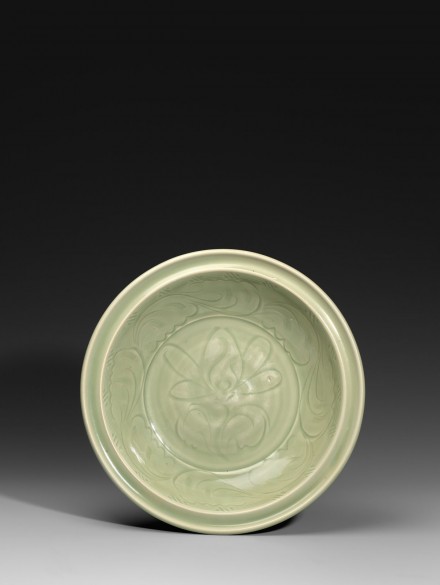J.J. Lally & Co., Oriental Art / New York City, New York
MenuPast Exhibition
The Gordon Collection:
Chinese Ceramics and Works of Art
March 12 - April 4, 2009

18.
A LARGE CARVED LONGQUAN CELADON DISH
Yuan Dynasty, mid-14th Century
decorated in the center with a freely incised lotus bloom in a wide central medallion encircled by a frieze of rising and falling foliate motifs carved and combed on the rounded sides of the well below a running border of keyfret, the wide everted concave rim with moulded lip, the underside plain and resting on a wide ring foot, covered with a bright sea-green glaze continuing over the foot and covering the recessed base except for a ring left unglazed for the kiln support, showing the stoneware body burnt reddish-brown in the firing.
Diameter 14 3⁄8 inches (36.5 cm)
A very similar carved Longquan celadon dish is illustrated by Krahl, Chinese Ceramics in the Topkapi Saray Museum, Istanbul, London, 1986, Vol. I, fig. 94, p. 263; the author mentions in the caption that a similar dish was excavated from the site of a 14th century Tughlaq Palace in Delhi.
Compare also the large Longquan dish of this form carved with a peony spray in the center and surrounded by the same foliate and keyfret bands in the well, illustrated in the catalogue of the exhibition shown at the Ashmolean Museum entitled Iron in the Fire: The Chinese Potters’ Exploration of Iron Oxide Glazes, Oriental Ceramic Society, London, 1988, no. 44, p. 54.
元 龍泉青瓷劃花蓮紋大盤 徑 36.5 厘米
18.
A LARGE CARVED LONGQUAN CELADON DISH
Yuan Dynasty, mid-14th Century
Diameter 14 3⁄8 inches (36.5 cm)